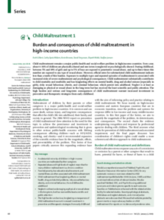Maltreatment of children by their parents or other caregivers is a major public-health and social-welfare problem in high-income countries. It is common and can cause death, serious injury, and long-term consequences that affect the child’s life into adulthood, their family, and society in general. The 2006 WHO report on prevention of child maltreatment1 drew attention to the need for this topic to achieve the prominence and investment in prevention and epidemiological monitoring that is given to other serious public-health concerns with lifelong consequences affecting children—such as HIV/AIDS, smoking, and obesity—and it recommended expansion of the scientific evidence base for the magnitude, effects, and preventability of the problem.
This paper is the first in a series of four papers that aim to critically assess this expanding evidence base with the aim of informing policy and practice relating to child maltreatment. The series focuses mainly on high-income countries and eastern European countries that are in economic transition, since the problem and systems for response differ in low-income and many middle-income countries. This first paper of the Series aims to quantify the magnitude of the problem, its determinants, and consequences.

